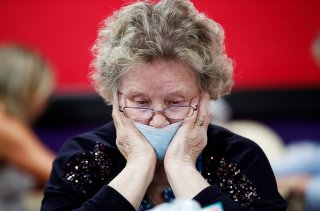Study: Spouses Most Likely to Transmit the Coronavirus
Spouses were deemed higher risk than other family members largely because of prolonged contact indoors and they often sleep in the same room.
Household spread of the coronavirus is common and rapid, with spouses often to blame for infecting family members, according to a new study published in the journal JAMA Network Open.
In a meta-analysis of fifty-four studies that involved a total of more than 77,700 participants in twenty countries, the researchers were able to conclude that 37.8 percent of coronavirus-positive patients eventually passed on the virus to their respective spouses.
Spouses were deemed higher risk than other family members largely because of prolonged contact indoors and they often sleep in the same room, the study noted.
“Infection risk was highest for spouses, followed by non-spouse family members and other relatives, which were all higher than other contacts,” the study’s authors wrote.
“Spouses were at higher risk than other family contacts, which may explain why the secondary attack rate was higher in households with one vs. three or greater contacts,” the researchers continued, adding that the data “may reflect intimacy, sleeping in the same room, or longer or more direct exposure to index cases.”
Risk was also elevated if a family member exhibited symptoms of coronavirus, such as coughing, sneezing, body aches, chills, and fever. Moreover, transmission of the virus was found to be higher between two adults compared to between an adult and a child.
This particular study comes after a U.S. Centers for Disease Control and Prevention report in November that discovered that 53 percent of individuals who lived with someone who tested positive also contracted it—“with approximately 75 percent of infections identified within five days of the index patient’s illness onset.”
Fewer than half of the infected household members exhibited symptoms at the time infection was first detected.
“The findings of this study suggest that given that individuals with suspected or confirmed infections are being referred to isolate at home, households will continue to be a significant venue for transmission of SARS-CoV-2,” the authors wrote.
Medical experts do note that staying isolated from other household members can be a great challenge, especially if a family lives in a smaller space and if there are children present.
In order to reduce the chance of virus transmission inside a home, experts recommend keeping an airflow with open windows or doors with screens.
The CDC has said that “improving ventilation helps remove respiratory droplets from the air.”
The agency also suggests keeping pets away from individuals who are known to be carriers of the virus.
“Since animals can spread other diseases to people, it’s always a good idea to practice healthy habits around pets and other animals,” the CDC said.
“If you must care for your pet or be around animals while you are sick, wash your hands before and after you interact with pets.”
Ethen Kim Lieser is a Minneapolis-based Science and Tech Editor who has held posts at Google, The Korea Herald, Lincoln Journal Star, AsianWeek, and Arirang TV. Follow or contact him on LinkedIn.
Image: Reuters

